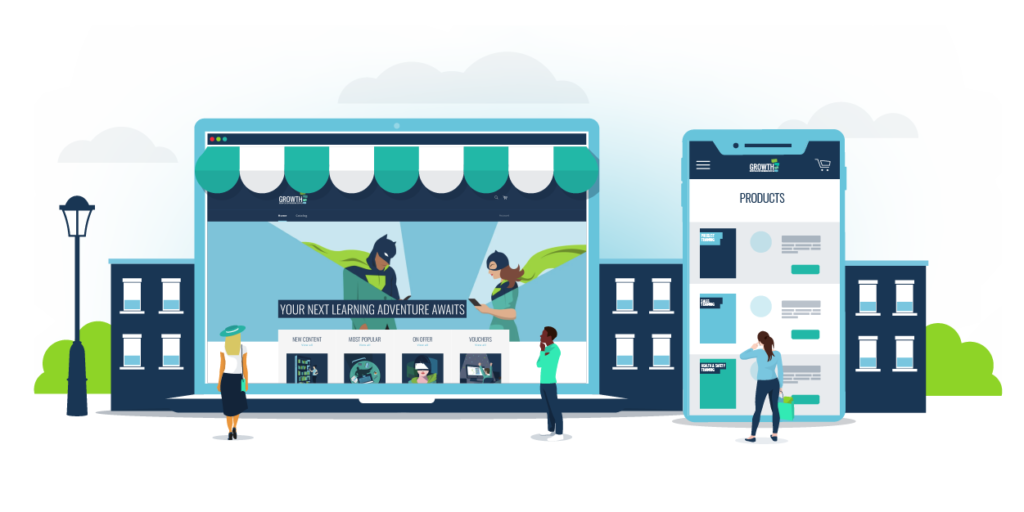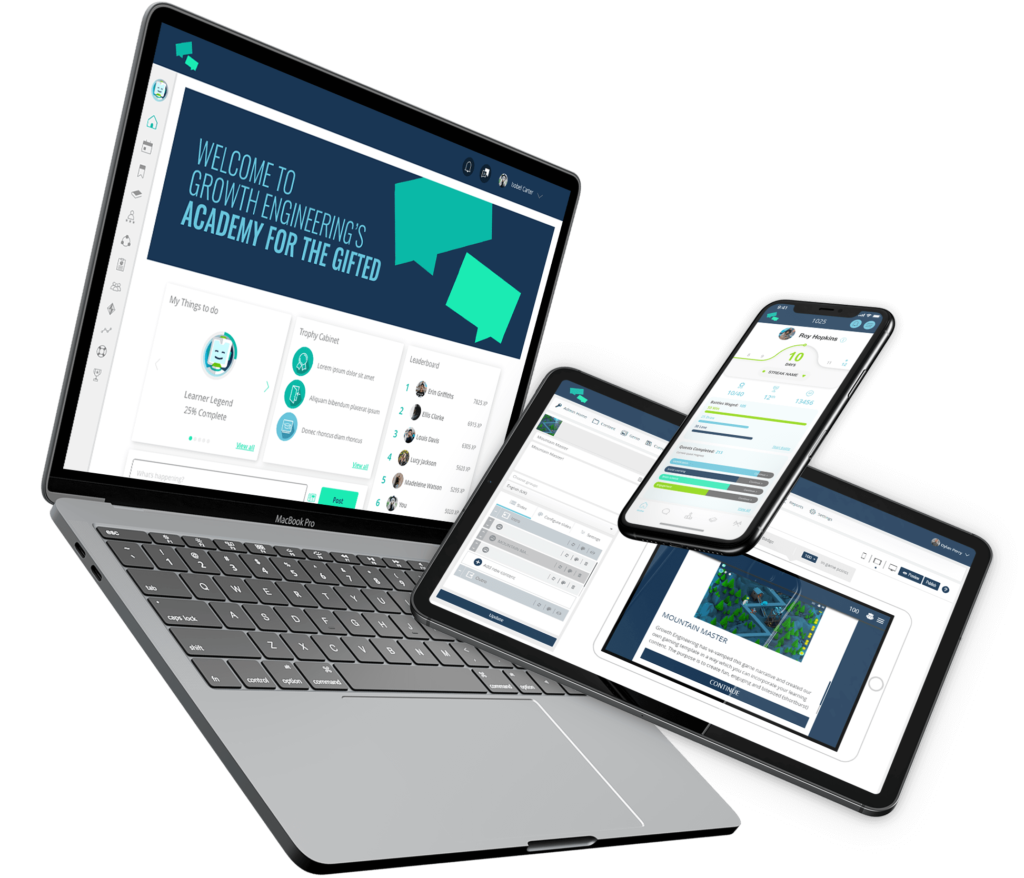
So, you’ve decided to make the move to online learning and purchase a learning management system (LMS). Congratulations! You’re about to embark on a journey of unlimited learner engagement and (if you play your cards right!) real business impact. That’s if you can find an LMS with a pricing model that fits your needs and budget.
Finding the right platform can be difficult. Once you’ve decided on the features you want it to have, you then need to find a solution with the right price point for your organisation. After all, different organisations have varying needs and wildly differing budgets.
Brandon Hall Group found that an LMS accounts for 38% of the average learning technology budget. As it’s such a big chunk, you need to be sure about what that cost covers and whether it’s right for your business.
As learning technology experts and an LMS provider ourselves, we’ve got you covered. In this article, we’ll guide you through the typical range of LMS prices. We’ll then give you some guidance on what that price includes. You’ll also learn what that price doesn’t include and we’ll help you to look out for any extra costs you may face.
Without further ado, let’s get started!
What’s the Current State of the LMS Market?
The eLearning market is currently worth an eye-watering $250 billion. This figure is only set to keep growing and is projected to hit $1 trillion by 2027.
LMSs play a big role in generating these figures. After all, there’s over 1,000 LMS vendors on the market and they all come with a hefty price tag.
Furthermore, an ATD survey found that 83% of organisations currently use an LMS. That’s a lot of businesses spending a lot of money on learning technology. It’s also often more than expected. According to Capterra, “People spend 59% more than they expect to on their Learning Management System.”
In fact, the global LMS market is currently valued at $15.8 billion. This figure can largely be attributed to the sudden surge in demand for learning technology due to the COVID-19 pandemic.
Let’s put this into context. To help meet demand, one online learning platform had to install 100,000 new cloud servers in just two hours!
However, investments into digital learning solutions are largely paying off. A Brandon Hall Group survey found:
- Nearly half of respondents (40%) saw at least a 10% profit increase as a result of investing in learning tech.
- 53% reported an increase of at least 10% in both productivity and engagement.
- 26% also stated that their costs decreased by 10% or more!
As such, many organisations and schools don’t plan to make the switch back to full face-to-face learning programmes. Consequently, by 2028 the LMS market is projected to be worth $44.9 billion, with a compound annual growth rate of 18.7%.
General Pricing Structure Guidance

So, what’s the cost of a typical LMS? Unfortunately, it’s hard to give a clear-cut answer. It varies quite a bit, depending on a number of factors! Let’s break down the differences.
Most LMS vendors use a Software as a Service (SaaS) model. This means that your LMS is hosted by your vendor and is distributed by the cloud.Users can access the platform through the web, without needing to download any software onto their devices. This also makes it easy to roll out updates to the platform, without interrupting the experience for your learners.
With a SaaS solution, there are two main fees to watch out for. The software itself is licensed on a subscription basis (leading to a License Fee). In most cases, you will also need to pay a Setup Fee. Confused? Let’s dig into the details!

1. Setup Fees
Setup Fees are one-off payments that an LMS provider requires to configure and implement your LMS. This will ensure your LMS is fully functional and ready to go. It includes:
- Design and configuration of your platform.
- Comprehensive administrator training.
- Project planning and management until platform launch.
In some cases, it will also include data and course migration from previous platforms. This helps to ease the administrative burden for your team.
For a SaaS LMS, the price of a Setup Fee is likely to range between $4,000 to $40,000. This fee varies based on the complexity of the implementation and the amount of custom development work required.
2. License Fees
Next up, we have the License Fee. Typically, you will be be given two licensing options:
- Monthly: You are charged a monthly fee for your platform, based on the number of user licenses you require.
- Annual: You are charged an annual fee for your platform, based on the number of user licenses you require. As you are paying for a longer term upfront, you are likely to receive a discount on the overall fee.
If you know you will be using your solution for at least a year and can afford to make the commitment, then we always recommend paying annual licence fees. This leads to larger savings over time.
Any variations in users over the course of the year (for instance, if you need to add new users to your platform), is typically invoiced pro rata.
The size of these fees will also depend on the length of your overall contract terms. If you’re willing to sign a three year agreement, rather than a single year deal, then you may receive further discounts.
Simple enough, right? Unfortunately, there’s another wrinkle to consider. Do you pay per registered user, or per active user?
Option 1: Pay-per User

You can likely guess how this pricing model works. The price you pay depends on how many users are registered on your LMS during each billing cycle (based on bands of users, rather than single units — more on this below).
You will be charged for each user, regardless of whether they log in, or complete any learning activities.
This is a good fit for those who don’t expect many user changes in each cycle and prefer a consistent figure. However, if you experience a volatile number of users (perhaps due to seasonal or temporary staff), then this likely isn’t the best fit for you.
Fees for this model are generally around $5 per user.

Option 2: Pay-per Active User
As we’ve seen, with a pay-per user model, there’s a set amount of registered users that you pay for regardless of LMS usage. With a pay-per-active user model, the price will vary depending on how many users accessed your LMS during a billing cycle.
This means you’re only paying for what you’ve used. Sounds good, right? On the other hand, your fees are much less foreseeable. This can affect your annual budgeting plans. Furthermore, the price per active user is typically higher than the price per registered user.
Fees for this pricing model can vary between $1 – $10 per active user.
The best model for you will depend on your own unique set of organisational needs. If you’re stuck, then we recommend asking your LMS vendor for a recommendation.

User Bands
Before we move on, there’s one last consideration to keep in mind. Most providers offer tiered pricing based on user bands. This means that the price per head decreases as the number of users on your platform increases.
As a result, the price per head for 10,000 users will be lower than the price per head for 1,000 users. This will help you to keep costs under control as you scale your platform. It also means that you will get more value from your LMS as you grow!
Open-Source LMSs
Of course, you could opt to forgo these pricing options completely by selecting an open-source LMS.
An open-source LMS will let anyone look at, change or improve the original code of the software for free. That’s right! You can find your very own LMS, without needing to pay any Setup or License Fees. You’re also free to customise and upgrade the platform as you see fit.
Sounds too good to be true, right?
However, as it’s free the functionality is often quite limited. You may also find that you generate unexpected costs. After all, you will have to pay to host the platform yourself. You’ll also need to provide support for the platform, manage upgrades and configure everything on your own. These costs can add up quickly.
Self-Hosted LMSs
An alternative to a SaaS LMS (where the vendor hosts your platform for you), or an open-source LMS is something called a self-hosted LMS. As the name suggests, you will be required to find a hosting solution for your platform.
This kind of LMS puts you in charge of its uptime, server security and upgrades. This can mean more independence from your vendor and customisation possibilities. Unfortunately, it can also mean higher upfront costs and less support if something goes wrong.
Other Considerations & Hidden Costs
As you can see, SaaS pricing has its complexities. There are also a number of hidden costs and other considerations that you should look out for. Check out the list below to guard yourself against any oversights!
Customer Support

Regardless of the pricing model, you should always consider the support you’ll receive after purchase. Some vendors (like us!) offer you a dedicated support team who are on hand to solve any issues.
If this is the case, you should check that there are clear and competitive Service Level Objectives linked to any contractual terms. This will help to give you peace of mind. After all, if anything does go wrong, you know you’ve got a team on hand ready to solve any challenge!
Others may only offer self-serve support capabilities, or require you to pay more for a comprehensive support package. Always read the fine print!
The type of support you receive is important. After all, 91% of unhappy customers leave and never return.
Training
Learning management systems are feature rich and can be difficult to master. As such, you should make sure you select a vendor who offers a comprehensive training programme for their platform.
In many cases, this will be included as part of the standard License Fee. After all, the vendor will want you to get the best possible value from their system. However, there may be exceptions to this rule.
eCommerce

Some LMS vendors will offer online ‘storefronts’ where you can sell your content. eCommerce functionality may be included as part of a standard License Fee, or at an additional cost.
For example, at Growth Engineering we’ve partnered with Shopify. This integration lets you sell your courses through your LMS. Your storefront is customisable, payments are secure and you can even create subscription models to boost sales!
Before you select a vendor, we would recommend asking what features aren’t included within their standard pricing. This will help you to identify any gaps and make a better informed purchasing decision.
Completing Your Ecosystem

Sometimes, organisational success may require more than an LMS. You may also need an app, an authoring tool and other solutions.
A modern learning solution needs to be available on various devices. After all, the modern learner is seemingly surgically attached to their phone. In fact, there are more than 6.3bn smartphone users in the world today. That’s 80% of the world’s population!
As such, mobile learning (mLearning) is very much on the rise. In fact, Towards Maturity found that 50% of all apps downloaded are used for learning purposes.
This is where Growth Engineering Learning App comes in. Our native app solution is easily downloadable onto your users’ devices and can be fully customised with your branding. We’ve also included a wealth of gamification and social functionality. As a result, your learners’ engagement levels are bound to soar.
Once you’ve got a digital learning platform in place, you’ll need some content to share with your learners. An authoring tool will help you to produce high-impact eLearning content with a minimum amount of fuss. In fact, the right one will cut down labour hours and save you approximately £3,315 per learning objective met.
Growth Engineering Authoring Tool comes with a wide array of features such as:
- Authoring capabilities
- Game templates
- Game mechanics
- Upload media in a variety of formats
- Various package exports
- Language translation
If you want the best of all worlds, then the Growth Engineering Impact Suite is perfect for you.
The Impact Suite includes access to Growth Engineering LMS, Growth Engineering Learning App and Growth Engineering Authoring Tool. Three multi-award winning solutions at an unbeatable price point. Please contact us for more details.
Building a Business Case for Learning Tech
Learning tech can be expensive to implement, but in the long-term you’ll save money and experience a range of other benefits. When building your business case you need to focus on:
- Controlling costs: Identify what you need and focus your spending accordingly.
- Engaging learners: Look for an engaging solution that will increase your ROI.
- Talking in numbers: Calculate the financial benefits of investing in learning tech and highlight them wherever possible. For example, one of our Fortune 500 clients was able to link a 20% increase in sales revenue to our mobile app solution!
Head to this blog for a full explanation of how to build a business case for your new learning tech solution!
Final Words
Making an enterprise level investment isn’t easy.
It’s important to make sure you know exactly what you’ll be getting out of your new LMS before purchasing. You should also be clear on all the different pricing models and options available to you, so you can make an informed decision.
You should also keep an eye out for any hidden costs that could arise at a later date. The more planning you do upfront, the fewer nasty surprises you’ll see down the line.
If the price is right, you’ll be ready to complete your purchase and kickstart your next learning journey. Awesomeness awaits!
Want to learn more about our pricing? Interested in exploring our multi-award winning learning technology solutions? Then get in contact with the engagement experts today!








